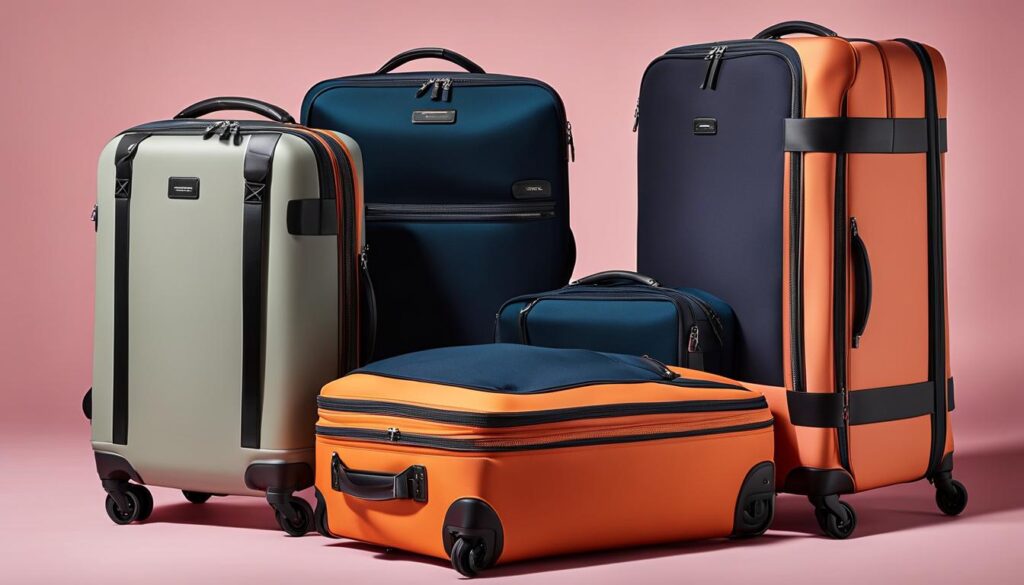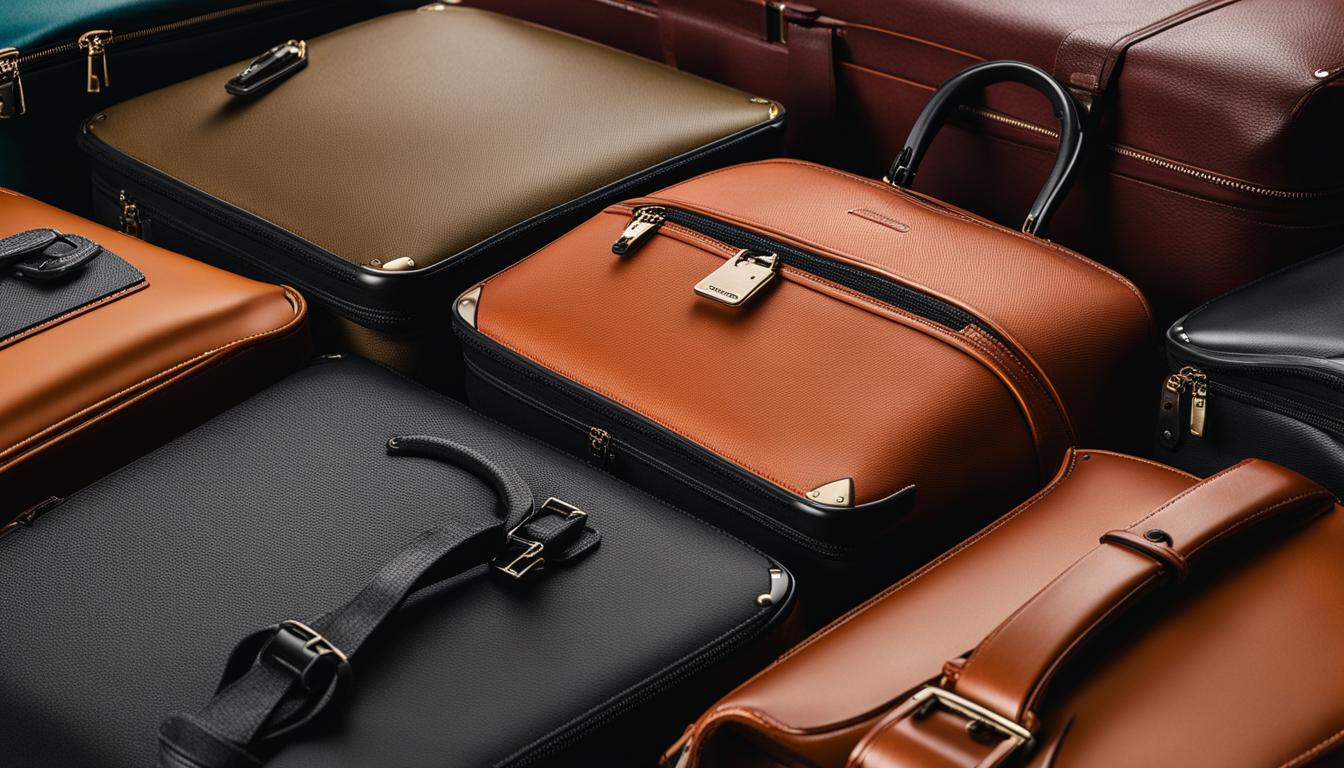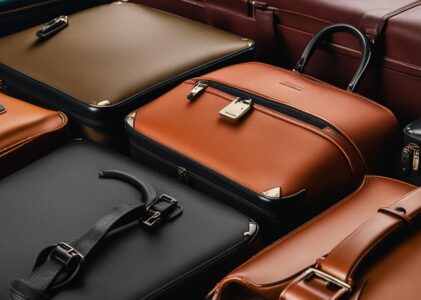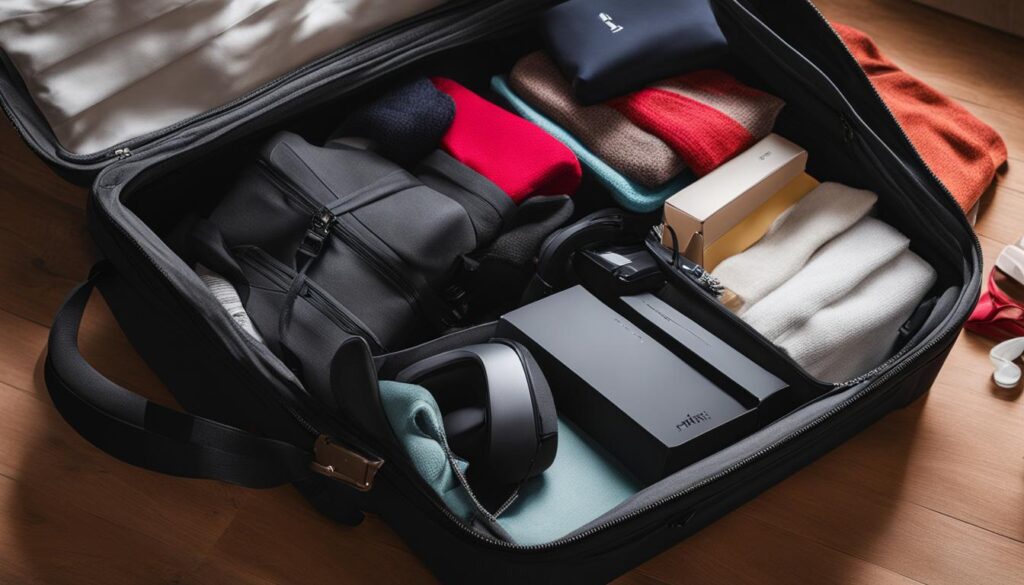When it comes to travel, having the right luggage material is essential. You want something that will not only protect your belongings but also make your journey more convenient. With so many options available, it can be overwhelming to choose the best luggage material for your needs. That’s why I’m here to help guide you through the different types of luggage materials and their pros and cons.
Key Takeaways:
- Choosing the best luggage material is crucial for protecting your belongings during travel.
- Consider factors like durability, weight, and quality when selecting a luggage material.
- Hard-side materials like polycarbonate and polypropylene offer more protection, while soft-side materials like nylon and polyester provide more flexibility.
- Finding the right balance between durability and weight is important for your specific travel needs.
- Remember to also consider factors like size, style, wheels, handles, and overall construction when buying luggage.
Hard-Side vs. Soft-Side Luggage
When it comes to choosing luggage, one of the first decisions you’ll need to make is whether to go with a hard-side or soft-side option. Both types have their own advantages and considerations, so let’s take a closer look at each.
Hard-Side Luggage
Hard-side luggage is known for its rigid protective shell, typically made from materials like ABS, polycarbonate, or polypropylene. This type of luggage offers maximum protection for your belongings, shielding them from impacts, scratches, and other mishaps during travel. If you’re carrying delicate or valuable items, hard-side luggage may be the preferred choice.
However, it’s important to note that hard-side luggage can be less versatile in terms of fitting into small or tight spaces. The rigid shell doesn’t offer much flexibility, making it challenging to squeeze into overhead compartments or tight trunks. So if you frequently travel on smaller aircraft or need to navigate crowded spaces, this is something to consider.
Soft-Side Luggage
On the other hand, soft-side luggage is made from flexible materials like nylon, polyester, or canvas. This type of luggage offers more flexibility in terms of fitting into tight spaces, as the fabric can be compressed or expanded as needed. Soft-side luggage is typically lighter in weight compared to hard-side options, making it easier to carry during your journey.
However, it’s important to note that soft-side luggage may provide less protection compared to hard-side options. While the fabric offers some resistance to scratches and impacts, it may not provide the same level of protection as a rigid shell. So if you’re carrying fragile or valuable items, you may want to opt for hard-side luggage instead.
| Hard-Side Luggage | Soft-Side Luggage | |
|---|---|---|
| Protection | High | Medium |
| Flexibility | Low | High |
| Weight | Medium to Heavy | Light to Medium |
| Style | Sleek and Modern | Versatile and Casual |
Ultimately, the choice between hard-side and soft-side luggage comes down to your specific travel needs. If you prioritize maximum protection for your belongings, hard-side luggage may be the ideal choice. On the other hand, if flexibility and lightness are more important to you, soft-side luggage offers greater convenience.
Polypropylene (PP) Luggage Pros and Cons
When it comes to choosing the right luggage material, polypropylene is one option that stands out. Known for its lightweight properties and budget-friendly price, polypropylene luggage offers a combination of convenience and durability. Let’s take a closer look at the pros and cons of this popular choice.
Pros of Polypropylene Luggage
Polypropylene luggage is highly regarded for its lightweight nature. This makes it easier to maneuver and carry, especially when you have multiple bags or are traveling long distances. The lightweight construction allows you to pack more without worrying about exceeding weight limits set by airlines.
Additionally, polypropylene is resistant to chemicals, temperature changes, and water. This means that your belongings are protected against spills, rain, and even extreme conditions. The material can withstand wear and tear, making it a reliable choice for frequent travelers.
Cons of Polypropylene Luggage
While polypropylene offers many benefits, it does have a few drawbacks to consider. One of the main concerns is its rigidity compared to other hard-side luggage materials, such as polycarbonate. Although polypropylene is still strong, it may not provide the same level of impact resistance as some other options.
Another consideration is that polypropylene luggage may degrade in color when exposed to UV light. Over time, prolonged exposure to the sun may cause the material to fade or discolor. Therefore, if you often travel to sunny destinations or spend a lot of time outdoors, you may want to take this into account.
Overall, polypropylene luggage is a reliable choice for travelers seeking lightweight yet durable options. Its resistance to chemicals, temperature, and water make it suitable for various environments. However, keep in mind the potential for color degradation and its slightly less rigid design compared to other hard-side materials.
| Pros | Cons |
|---|---|
| Lightweight | May not provide the same level of impact resistance as other hard-side materials |
| Resistant to chemicals, temperature, and water | May degrade in color when exposed to UV light |
Polycarbonate (PC) Luggage Pros and Cons
When it comes to choosing durable and lightweight luggage material, polycarbonate (PC) is definitely a top contender. PC luggage offers a perfect balance between strength and weight, making it a popular choice for travelers who value both durability and ease of use.
One of the key advantages of polycarbonate luggage is its exceptional durability. It is known for its high impact resistance, which means that it can withstand heavy impact without cracking or breaking. This makes it an ideal choice for frequent travelers who want reliable luggage that can endure the rigors of travel.
In addition to its durability, polycarbonate luggage is also incredibly lightweight. This makes it easy to maneuver and lift, even when fully packed. Travelers who prefer to pack more items without worrying about exceeding weight limits will appreciate the lightweight nature of polycarbonate luggage.
However, it’s important to note that polycarbonate luggage can be more expensive compared to other materials. The high cost is often attributed to the advanced manufacturing techniques used to create the strong and lightweight polycarbonate shells. Nevertheless, many travelers find that the investment is worth it for the added durability and ease of use.
Pros of Polycarbonate (PC) Luggage:
- Durable and impact-resistant
- Lightweight and easy to maneuver
Cons of Polycarbonate (PC) Luggage:
- Higher cost compared to other materials
Overall, polycarbonate luggage is an excellent choice for travelers who prioritize durability and lightweight design. While it may come with a higher price tag, the long-lasting nature and ease of use make it a worthwhile investment for frequent flyers. So, if you’re looking for luggage that can withstand the demands of travel while remaining light and easy to handle, polycarbonate is definitely a material worth considering.
Acrylonitrile Butadiene Styrene (ABS) Luggage Pros and Cons
ABS is a popular choice for hard-side luggage due to its affordability and durability. It is a lightweight material that offers rigidity and protection for your belongings. ABS luggage is known for its impact resistance, making it a suitable option for frequent travelers. However, there are some factors to consider before choosing ABS as your preferred luggage material.
One of the main advantages of ABS luggage is its affordability. Compared to other hard-side materials like polycarbonate and polypropylene, ABS is generally more budget-friendly. This makes it a great option for travelers who want a durable luggage material without breaking the bank.
However, it is important to note that ABS luggage is not the lightest option available. While it is lighter than traditional hard-shell materials, such as aluminum or steel, it can still be heavier compared to other hard-side materials like polycarbonate. This may affect the overall weight of your luggage, especially if you are trying to pack light.
Another consideration when choosing ABS luggage is the presence of plastic elements. ABS is a composite material made up of styrene, acrylonitrile, and butadiene, which may result in plastic elements such as handles or zippers. While these elements are generally sturdy, they can be more prone to breakage or damage compared to luggage made entirely of other materials like polycarbonate or polypropylene.
| Pros | Cons |
|---|---|
| Affordable | Not the lightest option |
| Durable | Possible presence of plastic elements |
| Impact resistant |

| Material | Durability | Weight | Water Resistance | Versatility |
|---|---|---|---|---|
| Polyester | High | Lightweight | Good | Flexible |
| Nylon | Very High | Light to Medium | Moderate | Very Flexible |
Leather and Canvas as Soft-Side Luggage Materials
When it comes to soft-side luggage materials, two popular options are leather and canvas. Both materials have their own unique characteristics and offer different advantages for travelers. Let’s take a closer look at these two options:
Leather Luggage
Leather is a classic and timeless choice for soft-side luggage. It is known for its durability and the luxurious look it adds to your travel gear. Leather luggage is often associated with style and sophistication, making it a popular choice for business travelers or those looking for a more elegant option.
One of the key advantages of leather luggage is its longevity. With proper care, leather bags can last for many years, making them a worthwhile investment. Additionally, leather is a natural material, which makes it an eco-friendly choice for travelers who prioritize sustainability.
Canvas Luggage
Canvas is another popular choice for soft-side luggage materials. Made from organic fibers like cotton or hemp, canvas is known for its strength and durability. It is highly resistant to wear and tear, making it a reliable option for frequent travelers.
While canvas may not have the same level of elegance as leather, it offers its own unique charm. Canvas luggage often has a casual and relaxed vibe, making it a popular choice for travelers who prefer a more laid-back style. Additionally, canvas is a lightweight material, which can be advantageous for those looking to pack as efficiently as possible.
Summary
In summary, both leather and canvas are excellent choices for soft-side luggage materials. Leather offers durability, elegance, and longevity, while canvas provides strength, reliability, and a more casual style. When choosing between these two options, consider your personal style preferences, the specific needs of your travel, and your commitment to sustainability.
Table: Comparison of Leather and Canvas as Soft-Side Luggage Materials
| Aspect | Leather | Canvas |
|---|---|---|
| Durability | High | High |
| Style | Elegant and sophisticated | Casual and relaxed |
| Longevity | Can last for many years with proper care | Durable, but may not last as long as leather |
| Weight | Heavier than canvas | Lightweight |
| Sustainability | Eco-friendly choice | Organic fibers, eco-friendly option |
Leather offers durability, elegance, and longevity, while canvas provides strength, reliability, and a more casual style.
Ultimately, the choice between leather and canvas as soft-side luggage materials comes down to personal preference and travel needs. Whether you prioritize style, durability, or sustainability, both materials can offer a great solution for your travel adventures.
Choosing the Right Luggage Material
When it comes to selecting the perfect luggage, finding the right material is crucial. You want a material that is durable, lightweight, and of high quality to ensure your belongings are protected throughout your travels. Whether you prefer hard-side or soft-side luggage, it’s important to consider these factors to make the best decision.
Hard-Side Luggage
Hard-side luggage, such as polycarbonate and polypropylene, offers excellent protection for your belongings. These materials are known for their durability and resistance to scratches, impacts, and water. Polycarbonate, in particular, is lightweight and flexible, making it a popular choice among travelers. However, hard-side luggage may be less flexible in terms of fitting into tight spaces.
Soft-Side Luggage
Soft-side luggage, made from materials like nylon and polyester, offers more flexibility and versatility. These materials are lightweight and provide more give when packing in extra items. Additionally, they are often scuff-resistant and can withstand normal wear and tear. However, soft-side luggage may not provide the same level of protection as hard-side luggage.
Choosing the Ideal Material
When choosing the right luggage material, it’s important to strike a balance between durability and weight. If you prioritize protection, hard-side polycarbonate or polypropylene luggage would be a suitable choice. On the other hand, if you value flexibility and versatility, soft-side nylon or polyester luggage would be a better option. Assess your travel needs and preferences to make an informed decision that will ensure your luggage lasts for many trips to come.
| Durability | Weight | |
|---|---|---|
| Hard-Side Luggage | Durable | Lightweight |
| Soft-Side Luggage | Less Durable | Lightweight |
Factors to Consider When Buying Luggage
When it comes to buying luggage, there are several important factors to consider in addition to the material. Taking the time to evaluate these factors will ensure that you choose durable and lightweight luggage that best suits your travel needs.
Size and Style
First and foremost, think about the size and style of luggage that will work best for you. Consider the length of your trips and the amount of belongings you typically travel with. If you tend to pack light, a smaller carry-on size may be sufficient. However, if you frequently travel for longer periods or need to carry more items, a larger checked bag may be necessary. Additionally, think about the style that suits your personal preferences and travel aesthetics.
Wheels and Handles
The functionality of your luggage is crucial for ease of travel. Look for luggage with sturdy, smooth-rolling wheels that can handle various terrains. Spinner wheels offer the most maneuverability, allowing you to effortlessly navigate through airports and streets. Additionally, consider the type and quality of handles. Telescopic handles that lock securely in place and have a comfortable grip will make transporting your luggage much more convenient.
Overall Construction
Assessing the overall construction of the luggage is essential for durability. Look for reinforced corners and edges, as these areas are more prone to wear and tear. High-quality stitching and zipper closures are also important to prevent any potential malfunctions. It’s worth investing in well-constructed luggage that will withstand the rigors of travel and last for many trips to come.
| Luggage Factor | Importance |
|---|---|
| Size and Style | High |
| Wheels and Handles | High |
| Overall Construction | High |
By considering these factors and selecting luggage that meets your specific needs, you can ensure a more enjoyable and stress-free travel experience. With durable, lightweight luggage, you’ll be able to pack with confidence, knowing that your belongings are well-protected and your journey will be smoother.
Conclusion
After careful consideration, I have reached the conclusion that choosing the best luggage material requires a thoughtful evaluation of various factors. It is crucial to prioritize durability, lightweight design, and long-lasting performance to ensure the safety of your belongings during travel.
Whether you opt for hard-side or soft-side luggage, there are options available that cater to your specific needs. For those seeking maximum protection, hard-side materials such as polycarbonate and polypropylene offer exceptional durability and strength. These materials are renowned for their ability to withstand impacts, scratches, and cracks, ensuring your belongings remain safe throughout your journey.
On the other hand, if flexibility and versatility are your priorities, soft-side luggage made from nylon and polyester should be your go-to choice. These materials offer a lightweight design, allowing you to easily maneuver through crowded airports and tight spaces. Additionally, they provide the flexibility to accommodate extra items when needed.
When investing in luggage, it is essential to strike the right balance between strength, flexibility, and style. By considering factors such as durability, weight, and price, you can select a material that meets all your requirements. Remember that the best luggage material is the one that reflects your travel needs and ensures the protection of your belongings throughout your adventures.
FAQ
What are the different types of luggage materials available?
The different types of luggage materials available include polypropylene, polycarbonate, ABS, nylon, polyester, leather, and canvas.
What is the difference between hard-side and soft-side luggage?
Hard-side luggage has a rigid protective shell made from materials like ABS, polycarbonate, or polypropylene, offering maximum protection. Soft-side luggage is made from flexible materials like nylon, polyester, or canvas, offering more flexibility.
What are the pros and cons of polypropylene (PP) luggage?
Polypropylene luggage is lightweight, budget-friendly, and resistant to chemicals, temperature, and water. However, it is not as rigid as polycarbonate and may degrade in color when exposed to UV light.
What are the pros and cons of polycarbonate (PC) luggage?
Polycarbonate luggage is strong, durable, and resistant to cracks, scratches, and impacts. It is also lightweight and flexible. However, it can be more expensive than other materials and may be less flexible than soft-side luggage.
What are the pros and cons of Acrylonitrile Butadiene Styrene (ABS) luggage?
ABS luggage is attractive in price, lightweight, and rigid. However, it can be the heaviest among hard-side materials and may have plastic elements that can break.
What are the pros and cons of polyester and nylon as soft-side luggage materials?
Polyester is lightweight, flexible, and scuff-resistant, while nylon is more tear and abrasion resistant. Both materials come in various types and offer durability.
What are the pros and cons of leather and canvas as soft-side luggage materials?
Leather is durable but heavier and susceptible to water damage. Canvas is durable but less weatherproof than synthetic materials. Both materials offer long-lasting quality and style.
What factors should I consider when choosing the right luggage material?
Factors to consider when choosing the right luggage material include durability, weight, and quality.
What factors should I consider when buying luggage?
When buying luggage, factors to consider include size, style, wheels, handles, and overall construction. Look for features that fit your travel needs, such as durability, lightweight design, and high-quality construction.
How do I choose the best luggage material?
Consider factors like durability, weight, and price when selecting the best material for your needs. Find the right balance between durability and weight for your travel needs.
Why is choosing the right luggage material important?
Choosing the right luggage material is essential for protecting your belongings during travel. Select a material that offers the right balance of strength, flexibility, and style.




